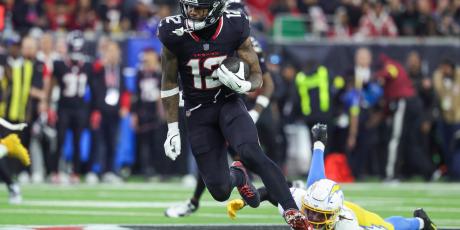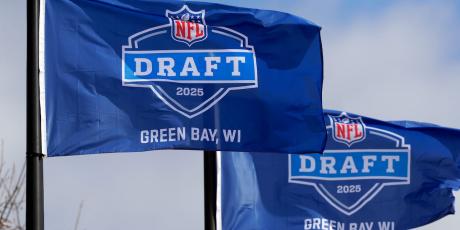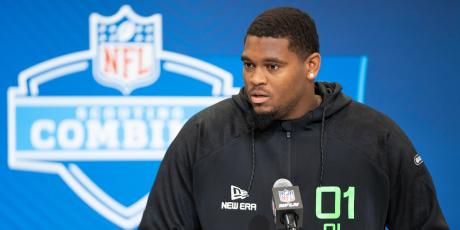MFL100s Best Ball Introduction and Strategy

There is almost no limit to the number of fantasy football Best Ball options now that the format has exploded in popularity. But as more and more fantasy football fans pick up the format, one of the oldest and most competitive options continues to be MFL100s. If your home league draft is over and you’re still looking for fantasy football options that require no in-season maintenance and offer substantial prizes, the MFL100 option is a great place to look.
What Are MFL100 Leagues?
MFL100 leagues are Best Ball leagues offered by the fantasy football site MyFantasyLeague.com (MFL). These leagues are offered at the $100 buy-in level and now offer two different prize structures for each 12-team league.
Traditional MFL100 leagues feature 12 teams with a first and second-place prize. First place takes home $1,000 while second place receives a free subscription to 4for4 Football (a $99 value). MFL100 also now offers the $100 Double Up option where first through fifth place receive $200 (doubling up their entry fee) and sixth place receive the $99 subscription from 4for4 Football.
Both of these prize option leagues offer the same format in terms of roster construction, number of rounds, and scoring. As Best Ball leagues, once the draft is over the work is done. There is no in-season trading, waiver wire, or weekly lineup setting. The MFL100 league (which is hosted on the popular NFFC website) does all the work for you, setting your optimal lineup to be scored against the rest of the league each week.
At 4for4, we have plenty of Best Ball analysis and strategy columns to assist with your drafting at MFL100s.
Drafting and Roster Construction
Each MFL100 draft consists of 20 rounds. Throughout those 20 rounds, drafters build a team that will compete using the following weekly lineup construction through Weeks 1-17 of the NFL season:
- 1 QB
- 2 RB
- 3 WR
- 1TE
- 1 Team Kicker (TK)
- 1 Team Defense/Special Teams (TDSP)
MFL100 leagues are unique in that there is not a traditional Flex option where an RB/WR/TE option is inserted. They are also different in that they require a Defense/Special Teams and a Team Kicker in weekly lineups. Below, we will discuss some strategies for how to approach TK and TDSP.
For Best Ball leagues like these, the goal is simply to have the most points in the league after 17 Weeks. There is no won-loss record or weekly opponents or playoffs, the goal is simply to maximize the possible amount of points that your lineup can score each week. And just like the No Fear shirts from the 1990’s said: Second Place is the First Loser.
MFL100 drafts follow a traditional snake draft format and once a league is filled, the draft software randomizes the draft order. There is no selecting of draft spots and also no Kentucky Derby-style draft preference that is available in other leagues hosted on the NFFC platform.
This year, there are two options available for draft clocks in MFL 100 leagues: two-hour clock and four-hour clock. My preference is the two-hour clock as it assures several draft picks are made each day, even with an overnight pause on the draft timer.
MFL100 Scoring and Strategy
MFL100s use a fairly standard PPR scoring format for skill position players, noting that quarterback passing touchdowns are six points (some sites use four), so pocket passers are slightly more elevated. Here are the scoring rules for offense in MFL100 leagues:
- Passing yards – 0.05 points per one yard
- Passing touchdowns – six points
- Passing 2-Pt Conversion – two points
- Interception – minus two points
- Rushing and Receiving Yards – 0.10 points per yard
- Rushing and Receiving Touchdowns – six points
- Rushing and Receiving 2-Pt Conversion – two points
- Reception – one point
- Lost Fumble – minus one point
- Kick Return/Punt Return/Fumble Return Touchdown – six points
As with any Best Ball product in the market today, the most profitable way to build MFL100 rosters will be through stacking. Stacking is essentially trying to get pieces from the same offense on one roster. For example, in 2024, a Kyler Murray-Marvin Harrison Jr.-Trey McBride stack has become very popular and is something easy to build on MFL100 leagues:
Marvin Harrison Jr. (ADP of 15.3)
Trey McBride (ADP of 52.0)
Kyler Murray (ADP of 79.0)
With this stack, you assume that any time the Cardinals score a lot of points in the game, Kyler Murray will have led that charge and involved his two top pass-catchers. Considering the condensed nature of their passing tree, it’s a good bet that if the Cardinals go off in one week, these three players were heavily involved.
The next advanced strategy on top of this would be correlation with opposing teams, especially in the final weeks of the contest. In Week 17, for example, the Cardinals play the Los Angeles Rams. If your draft started with Puka Nacua in the first round, Marvin Harrison Jr. in the second, and then added Murray and McBride later, if that Week 17 game is a shootout, your roster could possess all the best pieces.
Quarterback Strategy
The rise and proliferation of the rushing quarterback has made this position much more essential to Best Ball rosters. Consider this example: In 2015, the QB2 in points per game (Tom Brady, 21.5) was only 3.5 points per game better than the QB15 (Eli Manning (18.0). In 2023, the QB2 (Jalen Hurts, 21.9 points per game) was a full five points better than QB15 (Matthew Stafford, 16.9). Over a 17-week season, that can make a huge difference.
Considering stacking as a part of my strategy, I am looking to take one of the top-10 quarterbacks that go before pick 80. Each of these, except for C.J. Stroud and Joe Burrow, offer significant rushing upside and place them in a tier far above what quarterbacks can be found beginning with Brock Purdy (QB1, ADP of 93.7).
Exceptions to this in 2024 could be Jayden Daniels (QB12, ADP 100.8) and Caleb Williams (QB15, ADP 109.5). These rookies likely have depressed ADPs because of the unknown factor and we haven’t seen them do it before on the NFL level. However, if there are two signal-callers who are going to jump into that elite level in 2025, my money is on these two. If Daniels and Williams both have quarterback ADPs after 100 next season, it will be shocking.
After securing one of these top options, grabbing only one more quarterback to cover bye weeks is all that is necessary. If the backup is Daniels or Williams, fantastic! If those slip through to someone else, quarterbacks who have solid stacking options and have known to produce spike weeks like Tua Tagovailoa (101.4), Jared Goff (105.5), or Deshaun Watson (150.1) are solid options.
Running Back Strategy
As we approach the start of the 2024 regular season, we are starting to get a clearer sense of who will be starting running backs and who will dominate workloads for many offenses around the league. There are still some ambiguous situations such as the Cincinnati Bengals and Los Angeles Chargers, but the running back position has largely settled into the appropriate ADP based on this information.
Dual-threat backs are clearly the top of the pyramid in this PPR format, but they will all go in the first 2-3 rounds in MFL100 drafts. Christian McCaffrey, Breece Hall, and Bijan Robinson will be gone within the first seven picks of the draft and then the next eight backs will be gone by pick 30. If you miss out on one of the top three, one of the best strategies would be to double-tap wide receiver in the first two rounds and then try to grab one of Isiah Pacheco, Rachaad White, or James Cook in rounds 3-4.
Generally, I prefer a strategy that leaves me with five running backs in MFL100 formats. That includes two solid starters, at least one backup to a bell-cow who would be an RB1 with injury or opportunity, and then a couple of pass-catching backs who can have spike weeks in PPR formats. Candidates for these types of back would be Antonio Gibson, Tyjae Spears, Austin Ekeler, or Rico Dowdle.
With only two running backs started each week (and no opportunity for any more), loading up with seven or eight running backs minimizes the number of wide receivers that are available for a roster, that is the position that has become the lynchpin for Best Ball leagues.
Wide Receiver Strategy
My strategy with wide receivers in full PPR Best Ball formats is that is hard to have too many. Unless I can secure Christian McCaffrey, Breece Hall, or Bijan Robinson, I am likely taking a wide receiver with both of my first two picks (and many times my third, depending on who falls). With this format, you are starting three wide receivers each week (compared to just two running backs), so stocking up on this position is crucial.
Considering the fact that out of my 20 roster spots, 17 are going to be dedicated to skill players (more on that below), I want to leave my draft with no fewer than eight wide receivers in that format. Wide receivers have the highest upside outside the few bell-cow running backs each week. The PPR format elevates their floor, and there are always late-round options that pop during any given season.
Tight End Strategy
Like wide receivers, the tight end position is elevated in this format because of the full PPR scoring. It is true that only one can be started, and there is no flex to provide a spot for another. To me, that means I am looking to secure one of the top eight at the position whenever possible. After George Kittle (ADP of 79.5), there is a drop off in talent, tier, and ADP. The next tight end isn’t taken until after pick 90.
Assuming I get one of those top eight options, there is really only a need to draft one more tight end who can cover the position during a bye week. One of my favorite builds involves selecting Evan Engram in Round 7 (ADP of 73, Week 12 Bye) after drafting a quarterback, two running backs, and four wide receivers. Later in the draft, I will select someone like Dalton Schultz (ADP of 134.2) who plays the Tennessee Titans in Week 12 when Evan Engram is off.
Considering the requirement to select Team Kicker and Defense/Special Teams, it is not advisable to try and load up on three or four late-round tight ends and hope for a touchdown week from one of them each scoring period.
Team Kicker Strategy
With the Team Kicker option on MFL100, you don’t have to worry about drafting Jason Sanders or Justin Tucker just for them to strain a hamstring in Week 2 and be out for the year. With Team Kicker, you are receiving points for the extra points and field goals kicked by a team, regardless of who makes them.
Knowing this, bye weeks are still something that must be managed. The traditional way to build TK in MFL100s is to draft two somewhere in the last four rounds, making sure those teams do not have the same bye week. I have also seen rosters built where a manager wanted more RB/WR/TE options so they drafted just one TK (knowing that they are getting kicking points from the team no matter who kicks) and just takes a zero in that score for the one week the team is on bye.
This is my preferred way to build, especially if I draft TKs from teams like Baltimore, Houston, Dallas, Kansas City, or Miami. These are teams that will surely score a lot of points and give me an advantage on a team that takes kickers from less-prolific offenses. I would rather have another wide receiver who could pop off for 15 or 20 points in any game than have a kicker whose likely variance could be from zero to 15 points.
Defense Special Teams Strategy
Defense/Special Teams strategy should be fairly straightforward. Draft two of them and draft them in the last two rounds of the draft. Don’t worry if other people are taking the New York Jets in Round 15 or 16, that’s when you can load up on sleeper wide receivers or running backs.
DST scoring is extremely volatile and is almost impossible to predict. Knowing that the defense is going to play regardless of who is injured or who is on the other side of the field, all we are looking for are teams that like to rush the quarterback and teams that tend to allow a lot of quarterback drop-backs. The more quarterback drop-backs a defense faces, the higher the likelihood of more sacks and interceptions.
Any defense can have a spike week based on the opposing quarterback's play, but predicting them is incredibly difficult. I’ll take the more guaranteed points from skill positions earlier in the draft and then worry about defense at the end.
Defense/Special Teams scoring on MFL100s is defined below:
- Sacks – one point
- Interception – two points
- Fumble Recovery – two points
- Safeties – two points
- TDSP Interception TD Return – six points
- TDSP Fumble TD Return – six points
- TDSP Kick Return TD – six points
- TDSP Punt Return TD – six points
- TDSP Blocked Kick TD – six points
- Failed 2pt / PAT Return – two points
- Shutout - 12 points
- Points Allowed 2-7 – eight points
- Points Allowed 8-14 – four points
- Points Allowed 15-20 – two points
- Points Allowed 21-24 – one point





















